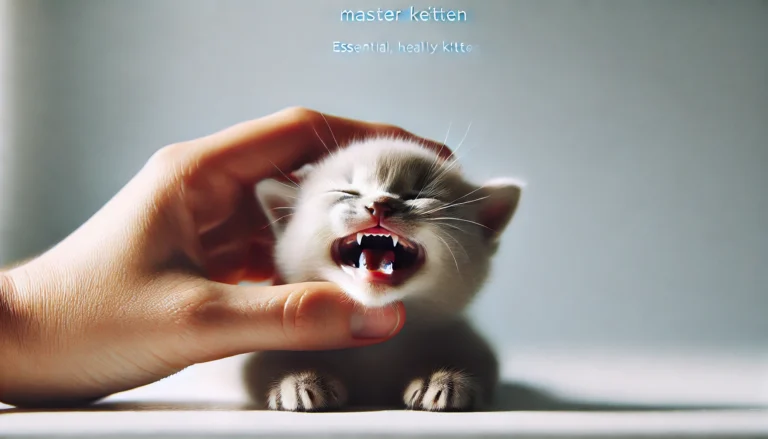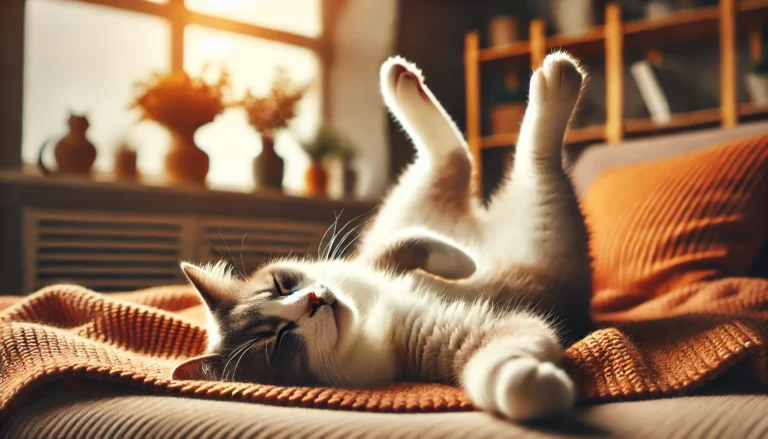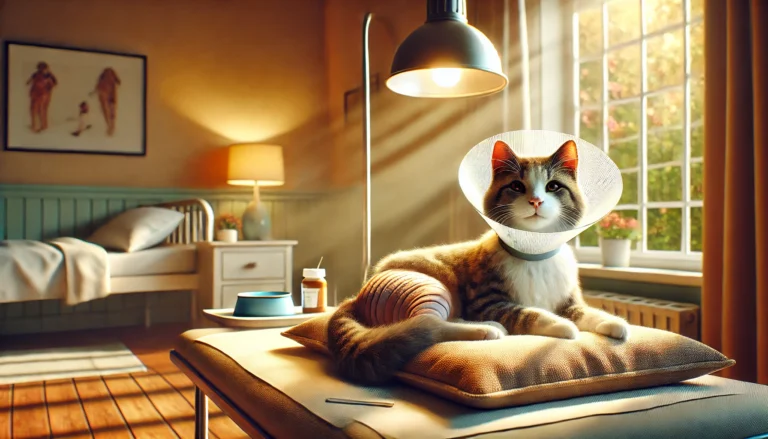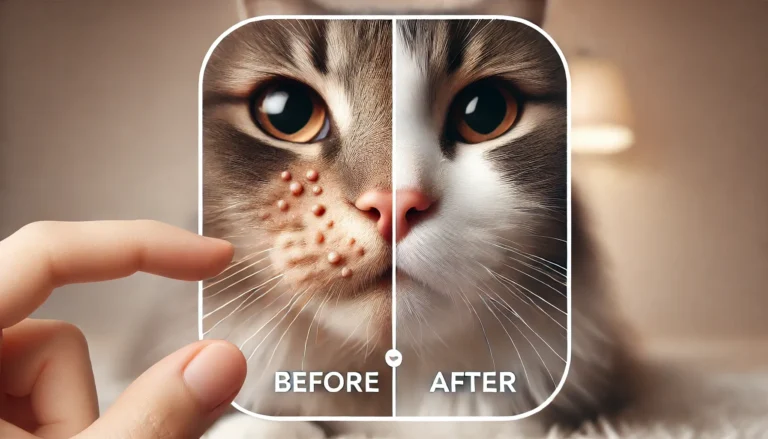Feline Distemper in Cats
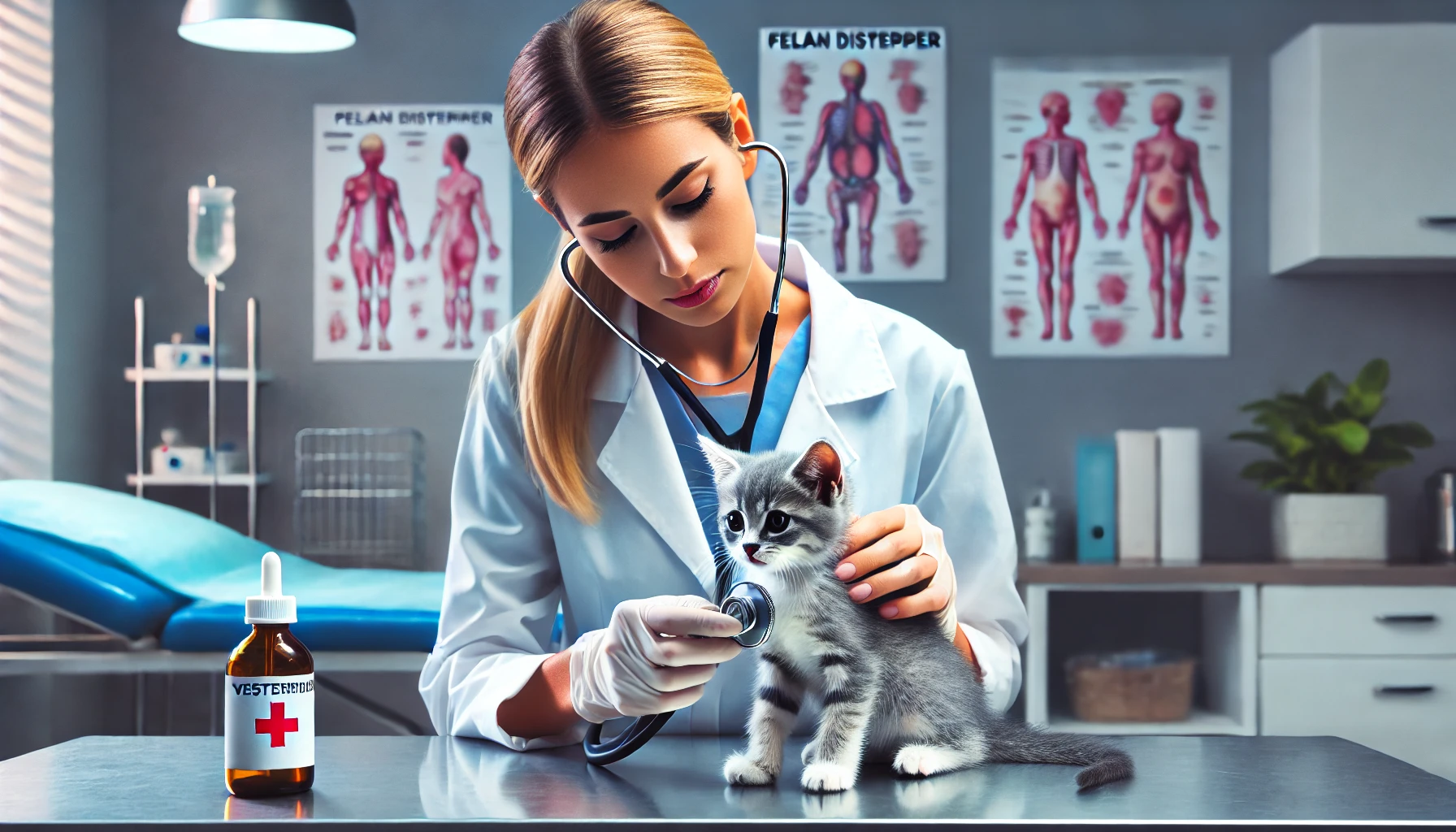
Feline Distemper in Cats
Feline Distemper in Cats, also known as panleukopenia, is a severe viral disease that poses a significant threat to the feline population. This guide provides an in-depth look at the disease, from its symptoms and transmission to treatment and prevention.
Understanding Feline Distemper
Key Symptoms of Feline Distemper:
- Fever – One of the first signs.
- Vomiting – Often severe and persistent.
- Diarrhea – Can be bloody, leading to dehydration.
- Loss of Appetite – Affected cats may refuse food and water.
- Lethargy – Affected cats become weak and inactive.
- Severe drop in white blood cell count – This compromises the immune system, leaving the cat vulnerable to secondary infections.
Transmission:
The virus is highly contagious and spreads through bodily fluids such as saliva, urine, feces, and even contaminated surfaces. It can also be transmitted by direct contact with infected cats or by people carrying the virus on their clothing or shoes.
How Feline Distemper Affects Cats:
The virus primarily attacks the cat’s bone marrow and intestines, disrupting the production of white blood cells and causing gastrointestinal damage. The immune system becomes weakened, which increases the risk of fatal infections. In severe cases, it can lead to neurological symptoms such as tremors or lack of coordination.
Prevention:
Vaccination is the most effective way to prevent feline distemper. The FVRCP vaccine (which protects against Feline Viral Rhinotracheitis, Calicivirus, and Panleukopenia) is typically administered to kittens in a series of shots starting at 6-8 weeks of age, with boosters throughout adulthood. Keeping cats indoors and avoiding contact with infected animals can also reduce the risk of exposure.
Treatment:
If a cat is diagnosed with feline distemper in cats, prompt veterinary care is critical. While there is no direct cure for the virus, supportive treatments can help the cat recover. This may include:
- Fluids and electrolytes to address dehydration.
- Antibiotics to treat secondary bacterial infections.
- Anti-vomiting medications and other symptom management strategies.
Without treatment, the mortality rate for feline distemper in cats is high, but with immediate veterinary intervention, many cats can survive, especially if caught early..
Transmission of the Disease
Transmission of Feline Distemper in Cats (Feline Panleukopenia) occurs through direct and indirect contact with infected cats or contaminated environments. The virus is highly contagious and can spread rapidly, especially in areas with multiple cats, such as shelters, breeding facilities, or catteries. Here’s how it spreads:
1. Direct Contact:
- Saliva, urine, and feces: The primary mode of transmission is through contact with an infected cat’s bodily fluids. The virus is shed in large amounts through urine, feces, and saliva, even if the infected cat is not showing symptoms.
- Bites or scratches: Though less common, the virus can also be transmitted through bites or scratches from an infected cat, as these can introduce infected fluids into the body.
2. Indirect Contact:
- Contaminated Objects: The virus can survive in the environment for long periods (up to a year or more), especially on surfaces like food and water bowls, bedding, litter boxes, and toys. Even if an infected cat is no longer present, these contaminated items can spread the virus to healthy cats.
- Human Carriers: People can unknowingly spread the virus on their clothes, shoes, or hands if they’ve come into contact with an infected cat or contaminated area. This is why strict hygiene and quarantine protocols are important in multi-cat environments.
3. Aerosol Transmission:
- In rare cases, the virus may be transmitted through the air, but this is not the primary method of spread. It’s more commonly spread via direct contact or contaminated environments.
4. Vertical Transmission (Mother to Kitten):
- In utero transmission: Pregnant cats infected with the virus can transmit it to their unborn kittens, resulting in fetal death, abortion, or birth defects. Kittens may also become infected if they come into contact with the mother’s bodily fluids during or after birth.
- Through mother’s milk: In rare cases, an infected mother may transmit the virus through her milk.
5. Fecal-Oral Transmission:
- Cats can ingest the virus if they lick or groom surfaces or objects contaminated with the feces or urine of an infected cat. The virus can also spread through shared litter boxes, food/water bowls, or if a healthy cat eats contaminated food or drinks infected water.
Preventing Transmission:
- Vaccination: Ensuring your cat is vaccinated against feline distemper (Panleukopenia) is the most effective way to prevent the spread of the virus.
- Quarantine and isolation: Infected cats should be isolated from healthy cats until they are no longer shedding the virus, typically after a period of treatment.
- Cleaning and Disinfecting: Regularly clean and disinfect surfaces, toys, litter boxes, and bedding with a disinfectant that kills the virus.
- Limiting exposure: Keep your cat indoors or limit their contact with potentially infected animals, especially in areas where outbreaks are common.
Symptoms of Feline Distemper in Cats
Symptoms of Feline Distemper (Feline Panleukopenia) can vary depending on the severity of the infection and the age or health of the cat. Infected cats may display a range of symptoms, from mild to severe. The virus primarily targets the immune system, gastrointestinal tract, and sometimes the nervous system. Here are the most common symptoms:
1. Fever
- A sudden spike in body temperature is one of the earliest signs of feline distemper in cats. It often occurs before other symptoms manifest.
2. Vomiting
- Vomiting is frequent and severe. Cats may vomit multiple times per day, leading to dehydration. This is one of the hallmark signs of the disease.
3. Diarrhea
- Diarrhea, which can be watery or bloody, is common and can lead to severe dehydration and weight loss. It is often accompanied by a foul odor.
4. Lethargy
- Cats infected with feline distemper in cats often become very weak and lethargic. They may sleep more than usual and avoid interacting with their owners or other animals.
5. Loss of Appetite
- Affected cats typically lose their interest in food and may stop eating or drinking altogether, which can contribute to rapid weight loss and dehydration.
6. Dehydration
- Due to vomiting, diarrhea, and a loss of appetite, dehydration can develop quickly. Signs of dehydration include dry gums, sunken eyes, and a loss of skin elasticity.
7. Drop in White Blood Cells (Leukopenia)
- One of the characteristic signs of feline distemper is a dramatic drop in the cat’s white blood cell count. This weakens the immune system, making the cat more susceptible to secondary infections.
8. Abdominal Pain
- Some cats may show signs of abdominal discomfort, such as abdominal tenderness or crying when their abdomen is touched.
9. Neurological Symptoms (In Severe Cases)
- In advanced stages or in very young kittens, neurological symptoms can occur. These might include:
- Tremors or shaking
- Lack of coordination (ataxia)
- Seizures
- Nystagmus (rapid eye movement)
10. Discharge from Eyes or Nose
- Some cats may develop a watery discharge from their eyes or nose, though this is less common compared to other viral infections like feline calicivirus or feline herpesvirus.
11. Jaundice (In Severe Cases)
- In rare cases, cats may develop jaundice (yellowing of the skin, eyes, or gums) due to liver involvement. This indicates a more severe form of the disease and requires immediate veterinary intervention.
12. Weak or Abnormal Gait
- In kittens or older cats, the virus can affect the nervous system, causing a wobbling gait, uncoordinated movement, or difficulty walking.
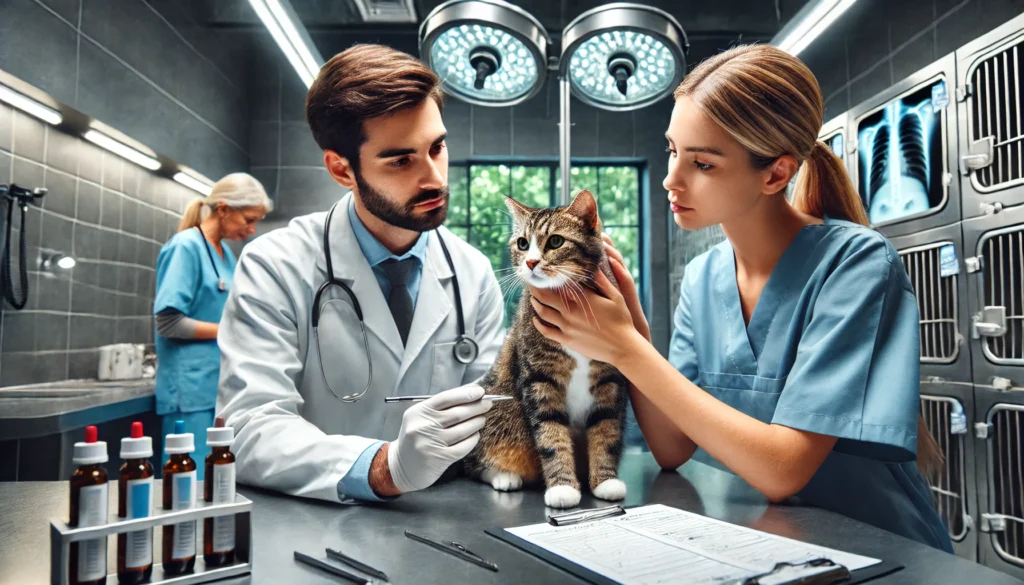
Diagnosis and Treatment
Feline distemper in cats is diagnosed primarily based on clinical signs, along with laboratory tests to confirm the presence of the virus. Due to the severity of the disease and its rapid progression, early diagnosis is critical.
1. Clinical Examination:
- A veterinarian will begin by conducting a thorough physical examination, looking for symptoms like fever, vomiting, diarrhea, lethargy, and loss of appetite.
- The history of the cat’s health, vaccination status, and potential exposure to other cats or environments with high disease risk (like shelters) are also considered.
2. Blood Tests:
- Leukopenia (low white blood cell count): One of the hallmark signs of feline distemper is a marked decrease in the number of white blood cells, which is detected via a complete blood count (CBC).
- Serology: Blood tests to detect antibodies or antigens specific to the feline parvovirus may be used to confirm the diagnosis, though it may not always be conclusive during the early stages.
- PCR (Polymerase Chain Reaction): This test can detect the DNA of the parvovirus in blood, feces, or other body fluids, offering a definitive diagnosis.
3. Fecal Test:
- The virus can be detected in the cat’s feces. A fecal PCR test is one of the most reliable methods to confirm the presence of feline panleukopenia.
4. Other Tests:
- Ultrasound or X-rays may be used in certain cases to rule out other diseases or to evaluate damage to internal organs, such as the intestines or liver.
Treatment of Feline Distemper
There is no cure for feline distemper, but early diagnosis and prompt supportive care can significantly improve the chances of survival. The treatment aims to support the cat’s immune system, manage symptoms, and prevent secondary infections.
1. Hospitalization:
- Hospitalization is often required, especially for severe cases. The cat may need to be kept in a isolation ward to prevent the spread of the virus to other animals and to provide a controlled environment for treatment.
2. Fluids and Electrolytes:
- IV fluids are essential to treat dehydration, a common side effect of vomiting and diarrhea. Electrolyte imbalances are also corrected with fluids, ensuring the cat’s body stays hydrated and its organs function properly.
3. Nutritional Support:
- Cats with feline distemper often stop eating due to nausea or abdominal pain. Appetite stimulants may be prescribed, and in some cases, a feeding tube might be necessary to ensure proper nutrition.
4. Antibiotics:
- Secondary bacterial infections are a significant risk due to the compromised immune system. Broad-spectrum antibiotics are commonly administered to prevent or treat infections resulting from the viral attack.
5. Anti-Vomiting and Anti-Diarrheal Medications:
- Medications such as antiemetics (to control vomiting) and anti-diarrheal agents may be used to help manage the gastrointestinal symptoms. However, diarrhea often requires cautious treatment, as the body needs to expel the virus.
6. Pain Management:
- Pain relief may be necessary if the cat is experiencing abdominal pain or discomfort from the virus’s effects on the intestines. Medications such as opioids may be prescribed to keep the cat comfortable.
7. Supportive Care for Neurological Symptoms:
- In severe cases, where neurological signs (tremors, seizures, lack of coordination) develop, anti-seizure medications or muscle relaxants may be used to manage symptoms.
8. Blood Transfusions:
- In extreme cases, a blood transfusion may be necessary if the cat suffers from severe anemia or if their white blood cell count is dangerously low.
9. Monitoring and Symptom Control:
- Continuous monitoring of vital signs, including temperature, blood pressure, and heart rate, is critical. Any changes in the cat’s condition can prompt immediate changes to the treatment plan.
do you know
Excessive water consumption can sometimes be harmless, tied to your dog’s activity level or the weather, but it can also be a symptom of serious health issues.
Long-Term Effects and Recovery
- Immune System Damage:
- Leukopenia (low white blood cell count) during the infection can leave the cat’s immune system weakened, making it more susceptible to future infections. While the immune system usually recovers after the infection, some cats may continue to be more vulnerable to other viruses or bacterial infections.
- Chronic Gastrointestinal Issues:
- Gastrointestinal damage caused by the virus can lead to long-term issues, such as intermittent vomiting, diarrhea, or reduced appetite. In some cases, the lining of the intestines may be permanently damaged, resulting in malabsorption or difficulties in digestion.
- Neurological Complications:
- Cats that experience severe neurological symptoms (tremors, seizures, uncoordinated movement) during the acute phase of the disease may suffer from long-term neurological effects. These can include:
- Cerebellar hypoplasia: This condition, where the cerebellum (the part of the brain responsible for coordination) is underdeveloped or damaged, can cause lifelong motor coordination problems such as a wobbly gait or difficulty walking.
- Tremors or seizures: Some cats may continue to experience shaking or even seizures long after the acute infection has passed.
- Behavioral changes: Neurological damage can lead to changes in behavior, including disorientation, confusion, or anxiety.
- Cats that experience severe neurological symptoms (tremors, seizures, uncoordinated movement) during the acute phase of the disease may suffer from long-term neurological effects. These can include:
- Reproductive Health Issues:
- Kittens born to infected mothers or unborn kittens that were exposed to the virus in utero may suffer from birth defects or neurological impairment. Infected mothers may also face complications with pregnancy or birthing.
- Growth and Development Delays:
Conclusion
Feline distemper in cats (also known as feline panleukopenia) is a highly contagious and often fatal viral disease that primarily affects a cat’s immune system, gastrointestinal system, and sometimes the nervous system. The disease is caused by the feline parvovirus and is especially dangerous for kittens and unvaccinated adult cats.Early diagnosis and veterinary intervention are crucial for improving the chances of recovery. Symptoms can range from fever, vomiting, and diarrhea to severe neurological signs in more advanced cases. Though there is no cure for the disease, supportive care, including IV fluids, medications, and nutritional support, can help the cat survive and recover.The long-term prognosis largely depends on the severity of the infection. While many cats can fully recover with prompt treatment, some may experience long-term effects, such as gastrointestinal issues or neurological impairments.
Can cats survive feline distemper?
Yes, cats can survive feline distemper, especially with early diagnosis and intensive veterinary care, though the mortality rate can be high without treatment.
How can I tell if my cat has feline distemper?
Symptoms of feline distemper in cats include fever, lethargy, vomiting, diarrhea, and severe dehydration. Blood tests by a vet can confirm the diagnosis.
What kills the feline distemper in cats virus?
The feline distemper in cats virus can be killed with bleach and other disinfectants that are effective against parvoviruses.
Is feline distemper in cats contagious to humans?
No, feline distemper in cats is not contagious to humans; it only affects cats.
Can distemper be cured?
There is no cure for distemper itself; treatment focuses on supportive care to manage symptoms and prevent secondary infections.
What are the first signs of feline leukemia?
Early signs of feline distemper in cats (FeLV) may include lethargy, weight loss, poor coat condition, and recurrent infections or illnesses.
What are the final stages of feline distemper in cats?
In the final stages of feline distemper in cats, cats may suffer from severe anemia, persistent diarrhea, neurological disorders, and opportunistic infections due to weakened immunity.

